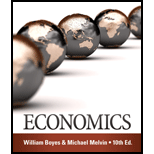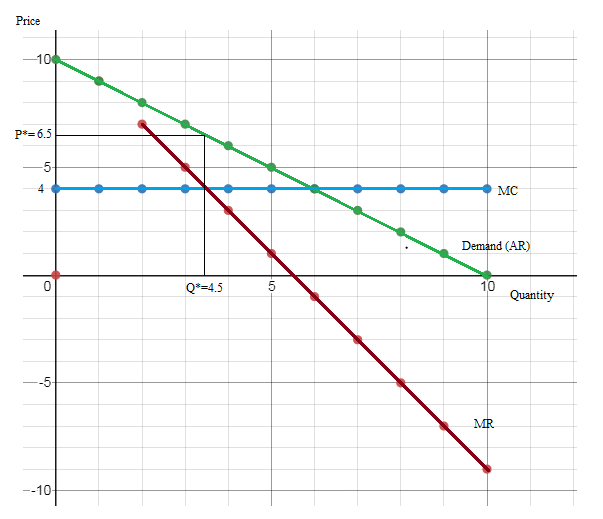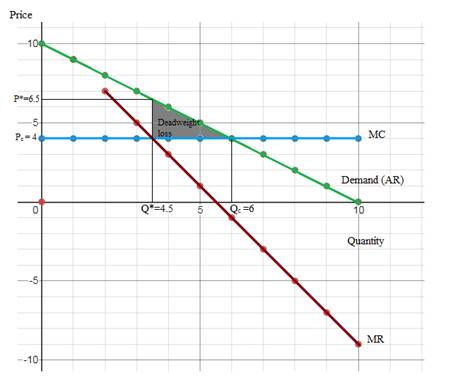
(a)
To compute:
The profit-maximizing quantity and price for the monopolist if marginal cost is constant at $4 at all levels of output.
Answer to Problem 14E
The profit-maximizing quantity and price are Q*=4.5 and P*=$6.5.
Explanation of Solution
The price and quantity schedule is given. The profit-maximizing output for a
The marginal cost is constant at $4 for all levels of output. The total proceeds or income from sale of a given level of output is called total revenue (TR). While the additional revenue generated from sale of an additional level of output is regarded a marginal revenue (MR).
First, calculate TR and MR using the formula below.
| Price (P) | Output (Q) | TR (Total Revenue) | MR (Marginal Revenue) | MC (Marginal Cost) |
| 10 | 0 | 0 | 0 | 4 |
| 9 | 1 | 9 | 9 | 4 |
| 8 | 2 | 16 | 7 | 4 |
| 7 | 3 | 21 | 5 | 4 |
| 6 | 4 | 24 | 3 | 4 |
| 5 | 5 | 25 | 1 | 4 |
| 4 | 6 | 24 | -1 | 4 |
| 3 | 7 | 21 | -3 | 4 |
| 2 | 8 | 16 | -5 | 4 |
| 1 | 9 | 9 | -7 | 4 |
| 0 | 10 | 0 | -9 | 4 |
Using the MR and MC schedules in the table above, draw the graph for MR and MC. The profit-maximizing quantity and price are Q*=4.5 and P*=$6.5.

Monopoly:
Monopoly is a market structure where only one seller exists, and product is differentiated.
The demand for a good is the quantity of that good that consumers are willing and able to purchase at different prices.
Total Revenue (TR):
The total proceeds or income from sale of a given level of output is called total revenue.
Marginal Revenue (MR):
The additional revenue generated from sale of an additional level of output is regarded a marginal revenue.
Average Revenue (AR):
When at any level of output, the total revenue is divided by that level of output, we get the average revenue. AR is also the demand curve.
Total cost (TC):
The total outlay in production activity is referred to as total cost.
Marginal Cost (MC):
The additional cost of producing an extra unit of output is referred to as the marginal cost of producing that unit of output.
(b)
To compute:
The
Answer to Problem 14E
The deadweight loss resulting from the production of monopoly output is $1.875.
Explanation of Solution
Perfect competition is a market structure where large number of buyers and sellers exist, and products are homogeneous. Monopoly is a market structure where only one seller exists, and product is differentiated.
The case of perfect competition is regarded as the benchmark case since the output produced is socially optimum where there is full utilization of resources and no underemployment exists. It implies that the competitive output is such that
Under monopoly, the monopolist produces where MR=MC. Monopoly results in deadweight loss since the output produced is less than socially optimum output.
The deadweight loss in case of monopoly is calculated and shown below:

Perfect competition:
It is a market structure where large number of buyers and sellers exist, and products are homogeneous.
Monopoly:
Monopoly is a market structure where only one seller exists, and product is differentiated.
Deadweight loss:
It is the loss in social surplus that is due to production of less than socially optimum output.
Demand:
The demand for a good is the quantity of that good that consumers are willing and able to purchase at different prices.
Total Revenue (TR):
The total proceeds or income from sale of a given level of output is called total revenue.
Marginal Revenue (MR):
The additional revenue generated from sale of an additional level of output is regarded a marginal revenue.
Average Revenue (AR):
When at any level of output, the total revenue is divided by that level of output, we get the average revenue. AR is also the demand curve.
Total cost (TC):
The total outlay in production activity is referred to as total cost.
Marginal Cost (MC):
The additional cost of producing an extra unit of output is referred to as the marginal cost of producing that unit of output.
Want to see more full solutions like this?
Chapter 11 Solutions
Bundle: Microeconomics, Loose-leaf Version, 10th + Mindtap Economics, 1 Term (6 Months) Printed Access Card
- 20. Factors 01 pro B. the technological innovations available to companies. A. the laws that regulate manufacturers. C. the resources used to create output D. the waste left over after goods are produced. 21. Table 1.1 shows the tradeoff between different combinations of missile production and home construction, ceteris paribus. Complete the table by calculating the required opportunity costs for both missiles and houses. Then answer the indicated question(s). Combination Number of houses Opportunity cost of houses in Number of missiles terms of missiles J 0 4 K 10,000 3 L 17,000 2 1 M 21,000 0 N 23,000 Opportunity cost of missiles in terms of houses Tutorials-Principles of Economics m health carearrow_forwardIn a small open economy with a floating exchange rate, the supply of real money balances is fixed and a rise in government spending ______ Group of answer choices Raises the interest rate so that net exports must fall to maintain equilibrium in the goods market. Cannot change the interest rate so that net exports must fall to maintain equilibrium in the goods market. Cannot change the interest rate so income must rise to maintain equilibrium in the money market Raises the interest rate, so that income must rise to maintain equilibrium in the money market.arrow_forwardSuppose a country with a fixed exchange rate decides to implement a devaluation of its currency and commits to maintaining the new fixed parity. This implies (A) ______________ in the demand for its goods and a monetary (B) _______________. Group of answer choices (A) expansion ; (B) contraction (A) contraction ; (B) expansion (A) expansion ; (B) expansion (A) contraction ; (B) contractionarrow_forward
- Assume a small open country under fixed exchanges rate and full capital mobility. Prices are fixed in the short run and equilibrium is given initially at point A. An exogenous increase in public spending shifts the IS curve to IS'. Which of the following statements is true? Group of answer choices A new equilibrium is reached at point B. The TR curve will shift down until it passes through point B. A new equilibrium is reached at point C. Point B can only be reached in the absence of capital mobility.arrow_forwardA decrease in money demand causes the real interest rate to _____ and output to _____ in the short run, before prices adjust to restore equilibrium. Group of answer choices rise; rise fall; fall fall; rise rise; fallarrow_forwardIf a country's policy makers were to continously use expansionary monetary policy in an attempt to hold unemployment below the natural rate , the long urn result would be? Group of answer choices a decrease in the unemployment rate an increase in the level of output All of these an increase in the rate of inflationarrow_forward
- A shift in the Aggregate Supply curve to the right will result in a move to a point that is southwest of where the economy is currently at. Group of answer choices True Falsearrow_forwardAn oil shock can cause stagflation, a period of higher inflation and higher unemployment. When this happens, the economy moves to a point to the northeast of where it currently is. After the economy has moved to the northeast, the Federal Reserve can reduce that inflation without having to worry about causing more unemployment. Group of answer choices True Falsearrow_forwardThe long-run Phillips Curve is vertical which indicates Group of answer choices that in the long-run, there is no tradeoff between inflation and unemployment. that in the long-run, there is no tradeoff between inflation and the price level. None of these that in the long-run, the economy returns to a 4 percent level of inflation.arrow_forward
- Suppose the exchange rate between the British pound and the U.S. dollar is £1 = $2.00. The U.S. government implementsU.S. government implements a contractionary fiscal policya contractionary fiscal policy. Illustrate the impact of this change in the market for pounds. 1.) Using the line drawing tool, draw and label a new demand line. 2.) Using the line drawing tool, draw and label a new supply line. Note: Carefully follow the instructions above and only draw the required objects.arrow_forwardJust Part D please, this is for environmental economicsarrow_forward3. Consider a single firm that manufactures chemicals and generates pollution through its emissions E. Researchers have estimated the MDF and MAC curves for the emissions to be the following: MDF = 4E and MAC = 125 – E Policymakers have decided to implement an emissions tax to control pollution. They are aware that a constant per-unit tax of $100 is an efficient policy. Yet they are also aware that this policy is not politically feasible because of the large tax burden it places on the firm. As a result, policymakers propose a two- part tax: a per unit tax of $75 for the first 15 units of emissions an increase in the per unit tax to $100 for all further units of emissions With an emissions tax, what is the general condition that determines how much pollution the regulated party will emit? What is the efficient level of emissions given the above MDF and MAC curves? What are the firm's total tax payments under the constant $100 per-unit tax? What is the firm's total cost of compliance…arrow_forward
 Microeconomics: Principles & PolicyEconomicsISBN:9781337794992Author:William J. Baumol, Alan S. Blinder, John L. SolowPublisher:Cengage Learning
Microeconomics: Principles & PolicyEconomicsISBN:9781337794992Author:William J. Baumol, Alan S. Blinder, John L. SolowPublisher:Cengage Learning Essentials of Economics (MindTap Course List)EconomicsISBN:9781337091992Author:N. Gregory MankiwPublisher:Cengage Learning
Essentials of Economics (MindTap Course List)EconomicsISBN:9781337091992Author:N. Gregory MankiwPublisher:Cengage Learning Principles of Economics (MindTap Course List)EconomicsISBN:9781305585126Author:N. Gregory MankiwPublisher:Cengage Learning
Principles of Economics (MindTap Course List)EconomicsISBN:9781305585126Author:N. Gregory MankiwPublisher:Cengage Learning Principles of Microeconomics (MindTap Course List)EconomicsISBN:9781305971493Author:N. Gregory MankiwPublisher:Cengage Learning
Principles of Microeconomics (MindTap Course List)EconomicsISBN:9781305971493Author:N. Gregory MankiwPublisher:Cengage Learning Principles of Economics, 7th Edition (MindTap Cou...EconomicsISBN:9781285165875Author:N. Gregory MankiwPublisher:Cengage Learning
Principles of Economics, 7th Edition (MindTap Cou...EconomicsISBN:9781285165875Author:N. Gregory MankiwPublisher:Cengage Learning Exploring EconomicsEconomicsISBN:9781544336329Author:Robert L. SextonPublisher:SAGE Publications, Inc
Exploring EconomicsEconomicsISBN:9781544336329Author:Robert L. SextonPublisher:SAGE Publications, Inc





